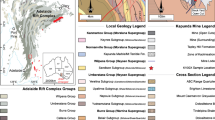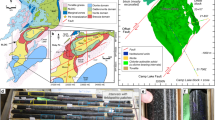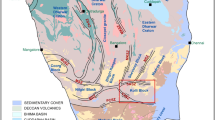Abstract
The borate mineralization of the Pitkáranta skarn field of Karelia is localized in metasomatically altered Proterozoic dolomites. In the contact aureole of rapakivi granites, the zoning of magnesian skarns includes spinel-diopside or fassaite skarns with syngenetic magnetite and spinel-forsterite calciphyres surrounded by periclase marbles, which confirms their hypabyssal genesis. Stringer-stockwork bodies developing in the brecciation zone at the roof show a primitive zoning consisting of an inner diopside and an outer forsterite calciphyre zone grading into a dolomitic marble. All these zones inherited the Ca/Mg ratio of the primary carbonate rocks. Rhythmically banded textures observed in the skarns and calciphyres of the deposits studied suggest their formation under thermodynamically disequilibrium conditions typical of hypabyssal metasomatites. Magnesium and magnesium-iron borates in marbles and calciphyres and beryllium borates in greisens were formed during the postmagmatic stage. Data are reported on the chemical composition and genesis of suanite, kotoite, ludwigite, hulsite, pertsevite, fluoborite, szaibelyite, and humites from the Hopunvaara, Klara, Lupikko, and Herberz deposits. The deficit of boron in magnesian borates is related to their endogenous hydration. Data on hambergites and berborite are given according to E.I. Nefedov.
Similar content being viewed by others
References
O. Trustedt, “Die Erzlagerstatten von Pitkäranta am Ladoga See,” Bull. Commis. Geol. Finl. 19, Part 5 (1907).
R. E. Liesegang, Geologische Diffusionen (Dresden und Leipzig, 1913).
M. Saksela, “Zur Mineralogie und Enstonung der Pitkäranta Erze,” Bull. Commis. Geol. Finl. 154, 181–231 (1951).
R.A. Khazov, Metallogeny of the Ladoga-Botnic Geoblock of the Baltic Schield (Nauka, Moscow, 1982) [in Russia].
R. A. Khazov, Geological Features of the Tin Mineralization of the Northern Ladoga Region (Nauka, Leningrad, 1973) [in Russian].
S. F. Lugov and R. A. Khazov, “Geology of Tin-Bearing Districts and Deposits in the Pre-Riphean Fold Structures of the Northern Ladoga Region,” in Geology of Tin Deposits of the USSR (Nedra, Moscow, 1986), Vol. 2, No. 2, pp. 148–171 [in Russian].
S. M. Aleksandrov, Geochemistry of Boron and Tin in Magnesian-Skarn Deposits (Nauka, Moscow, 1982) [in Russian].
V. I. Ivashchenko, Tin and Tungsten Skarn Mineralization in the Southern Baltic Shield (Nauka, Leningrad, 1987) [in Russian].
S. M. Aleksandrov, Geochemistry of Skarn and Ore Formation in Dolomites (Nauka, Moscow, 1990) [in Russian].
S. M. Aleksandrov, “Assimilation of Metamorphic and Metasomatically Altered Carbonate Sequences by Granitic Magmas,” Geokhimiya, No. 11, 1398–1414 (1992).
S. M. Aleksandrov, “Skarn Formation after Dolomites at the Contact of Granite Magmas,” Geokhimiya, No. 6, 801–820 (1993).
P. Escola and A. Juurinen, “Fluoborite from Pitkaranta,” Bull. Commis. Geol. Finl. 157, 181–231 (1952).
E. I. Nefedov, “Magnesioborite-A New Mineral,” Mater. VSEGEI, Novaya Seriya, No. 45, 243–247 (1961).
M. E. Mrose and M. Fleischer, “The Probable Identity of Magnesioborite with Suanite,” Am. Mineral. 48, 915–924 (1963).
E. I. Nefedov, “Berborite-A New Mineral,” Dokl. Akad. Nauk SSSR 174, 114–117 (1967).
E. I. Nefedov, “Mineralogy of the Pitkyaranta Deposit,” in “Ore Potential and Mineralogy of the Skarnoids of Southern Karelia and the Western Kola Peninsula” (VSEGEI, Leningrad, 1973) [in Russian].
S. M. Aleksandrov, V. L. Barsukov, and V. V. Shcherbina, Geochemistry of Endogenous Boron (Nauka, Moscow, 1968) [in Russian].
R. V. Lobzova and N. N. Pertsev, “Finding of Kotoite in Marble from the Northern Ladoga Region,” Zap. Vses. Mineral. O-va 117, 348–351 (1988).
A. E. Lisitsyn, S. V. Malinko, and V. V. Rudnev, “Borates of Pitkyaranta: Distribution and Composition,” Mineral. Zh. 13(1), 49–60 (1991).
V. V. Rudnev, “Monoclinic Fe-Mg Oxyborates of the Hulsite Isomorphic Series,” Zap. Vseros. Mineral. O-va 125, 89–108 (1996).
S. M. Aleksandrov and M. A. Troneva, “Endogenic Orthoborates in Europe: Genesis and Composition,” Geokhimiya, No. 6, 639–656 (2002) [Geochem. Int. 40, 576–593 (2002)].
S. M. Aleksandrov, “Phenomena of Self-Organization during the Progressive Metasomatism of Carbonate Rocks,” Geokhimiya, No. 9, 1323–1338 (1995).
P. Glansdorf, and I. Prigogine, Thermodynamic Theory of Structure, Stability and Fluctuations (Wiley-Interscience, New York, 1971; Mir, Moscow, 1973).
G. Nikolis and I. Prigogine, Self-Organization in Non-Equilibrium Systems (Wiley, New York, 1977; Mir, Moscow, 1979) [in Russian].
S. M. Aleksandrov, “Endogenous Transformations of Kotoite in Calciphyres at Magnesian-Skarn Deposits of Boron,” Geokhimiya, No. 7, 733–752 (2007) [Geochem. Int. 45, 666–684 (2007)].
S. M. Aleksandrov, “Genesis and Composition of Ore-Forming Magnesian Borates, Their Analogues, and Modifications,” Geokhimiya, No. 5, 492–512 (2003) [Geochem. Int. 41, 440–458 (2003)].
I. Ya. Nekrasov, A. P. Grigor’ev, T. A. Grigor’eva, et al., Study of High-Temperature Borates (Nauka, Moscow, 1970) [in Russian].
S. M. Aleksandrov, “Experimental Study of Kotoite Abyssophobity in the MgO-B2O3-H2O-CO2 System,” Geokhimiya, No. 12, 1879–1882 (1974).
S. M. Aleksandrov, “Geochemical Features of the Endogenous Hydration of Magnesium Borates,” Geokhimiya, No. 6, (2008) [Geochem. Int. 46, 578–594 (2008)].
W. Schreyer, T. Armbruster, H.-J. Bernhardt, and O. Medenbach, “Pertsevite, a New Silicatian Magnesioborate Mineral with an End-Member Composition Mg2BO3F, in Kotoite Marble from East of Verkhoyansk, Sakha-Yakutia, Russia,” Eur. J. Mineral. 15, 1007–1018 (2003).
S. M. Aleksandrov and M. A. Troneva, “Heterovalent Isomorphism in the Magnesium-Iron Borates,” Geokhimiya, No. 8, 862–876 (2008) [Geochem. Int. 46, 800–813 (2008)].
N. N. Pertsev, W. Schreyer, T. Armbruster, et al., “Alumino-Magnesiohulsite, a New Member of Hulsite Group, in Kotoite Marble East of Verkhoyansk, Sakha-Yakutia, Russia,” Eur. J. Mineral. 16, 151–161 (2004).
S. M. Aleksandrov, M. A. Troneva, and G. E. Kuril’chikova, “Boron-Tin Mineralization in Contact Aureole at Brooks Mountain, Alaska, the USA: Composition and Geochemical Evidence for Genesis,” Geokhimiya, No. 8, 852–868 (2000) [Geochem. Int. 38, 772–787 (2000)].
S. M. Aleksandrov, M. A. Troneva, and G. E. Kuril’chikova, “Tin-Bearing Borates of Hulsite-Paigeite Series from Skarn Deposits of Northeastern Russia: Composition and Geochemical Evidence for Genesis,” Geokhimiya, No. 7, 746–759 (2000) [Geochem. Int. 38, 676–688 (2000)].
G. Yang, Z. Peng, and Z. Pan, “Magnesiohulsite-A New Tin-Rich Borate Mineral,” Acta Mineral. Sinica 5(1), 95–101 (1985).
J. D. Dana, E. S. Dana, C. Palache, G. Berman, and C. Frondel, Dana’s System of Mineralogy (Wiley, New York, 1951; Inostrannaya Literatura, Moscow, 1953).
F. DeVito and A. Ordway, “The Jensen Quarry, Riverside County, California,” Mineral. Record 15(5), 273–290 (1984).
Mineralogy of Hydrothermal Beryllium Deposits, Ed. by A. I. Ginzburg (Nedra, Moscow, 1976) [in Russian].
A. P. Grigor’ev, A. A. Brovkin, and I. Ya. Nekrasov, “On a New Asharite Variety,” Dokl. Akad. Nauk SSSR, No. 4, 937–940 (1963).
V. A. Zharikov and B. I. Omel’yanenko, “Some Problems of the Study of Host Rock Alteration in Connection with Metallogenic Studies,” in Investigation of Regularities in the Localization of Mineralization during Metallogenic Studies of Ore Districts (Nedra, Moscow, 1965), pp. 119–194 [in Russian].
S. M. Aleksandrov and V. G. Senin, “Genesis, Composition, and Evolution of Sulfide Mineralization in Magnesian Skarns,” Geokhimiya, No. 6, 614–633 (2005) [Geochem. Int. 43, 559–577 (2005)].
E. I. Nefedov, W. I. Griffin, and R. Kristiansen, “Minerals of the Schoenfliesite-Wickmanite Series from Pitkäranta, Karelia, U.S.S.R,” Can. Mineral. 15, 437–445 (1977).
S. M. Aleksandrov, “Gold Behavior during Endogenic and Supergene Alterations of Sulfides in Magnesian Skarns,” Geokhimiya, No. 2, 180–198 (2007) [Geochem. Int. 45, 152–169 (2007)].
Author information
Authors and Affiliations
Corresponding author
Additional information
Original Russian Text © S.M. Aleksandrov, M.A. Troneva, 2009, published in Geokhimiya, 2009, No. 9, pp. 972–987.
Rights and permissions
About this article
Cite this article
Aleksandrov, S.M., Troneva, M.A. Composition and genesis of endogenous borates from the Pitkáranta ore field, Karelia. Geochem. Int. 47, 914–929 (2009). https://doi.org/10.1134/S0016702909090055
Received:
Published:
Issue Date:
DOI: https://doi.org/10.1134/S0016702909090055




